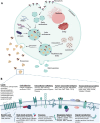Extracellular Vesicles in cancer: from isolation and characterization to metastasis, drug resistance, and clinical applications
- PMID: 40629268
- PMCID: PMC12235885
- DOI: 10.1186/s12885-025-14375-7
Extracellular Vesicles in cancer: from isolation and characterization to metastasis, drug resistance, and clinical applications
Abstract
Cancer progression, along with other hallmarks of cancer, is sustained through bidirectional cell-to-cell communication. This function is primarily facilitated by lipid-rich nanoparticles expelled into the extracellular matrix by stromal and/or malignant cells. These entities, known as extracellular vesicles, contain a vast repertoire of bioactive molecules and hold promise as potential biomarkers and nanovehicles for drug delivery. Intriguingly, the cellular and molecular mechanisms governing the functions of extracellular vesicles remain poorly understood. In the present manuscript, we highlight the intracellular and intercellular journey of extracellular vesicles, from their inception to the present day, their implications in various hallmarks of cancer, and their clinical applications.
Keywords: Biomarkers; Cancer progression; Drug resistance; Extracellular vesicles.
© 2025. The Author(s).
Conflict of interest statement
Declarations. Ethics approval and consent to participate: Not applicable. Consent for publications: Not applicable. Competing interests: The authors declare no competing interests.
Figures



Similar articles
-
Bacterial Extracellular Vesicles: Bridging Pathogen Biology and Therapeutic Innovation.Acta Biomater. 2025 Jun 15;200:1-20. doi: 10.1016/j.actbio.2025.05.028. Epub 2025 May 9. Acta Biomater. 2025. PMID: 40349898 Review.
-
Isolation and characterization of bone mesenchymal cell small extracellular vesicles using a novel mouse model.J Bone Miner Res. 2024 Oct 29;39(11):1633-1643. doi: 10.1093/jbmr/zjae135. J Bone Miner Res. 2024. PMID: 39173022
-
Biogenesis and functional implications of extracellular vesicles in cancer metastasis.Clin Transl Oncol. 2025 Jul;27(7):2913-2935. doi: 10.1007/s12094-024-03815-8. Epub 2024 Dec 20. Clin Transl Oncol. 2025. PMID: 39704958 Review.
-
Brain-derived extracellular vesicles: A promising avenue for Parkinson's disease pathogenesis, diagnosis, and treatment.Neural Regen Res. 2026 Apr 1;21(4):1447-1467. doi: 10.4103/NRR.NRR-D-24-01262. Epub 2025 Apr 29. Neural Regen Res. 2026. PMID: 40313118
-
Extracellular vesicles: the "Trojan Horse" within breast cancer host microenvironments.Mol Cancer. 2025 Jun 23;24(1):183. doi: 10.1186/s12943-025-02358-y. Mol Cancer. 2025. PMID: 40551109 Free PMC article. Review.
References
-
- Urabe F, Kosaka N, Ito K, Kimura T, Egawa S, Ochiya T. Extracellular vesicles as biomarkers and therapeutic targets for cancer. Am J Physiol Cell Physiol. 2020;318(1):C29–39. - PubMed
-
- van Niel G, Carter DRF, Clayton A, Lambert DW, Raposo G, Vader P. Challenges and directions in studying cell-cell communication by extracellular vesicles. Nat Rev Mol Cell Biol. 2022;23(5):369–82. - PubMed
Publication types
MeSH terms
Grants and funding
LinkOut - more resources
Full Text Sources
Medical

